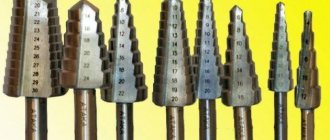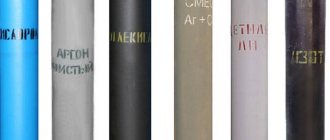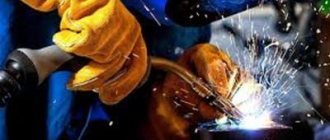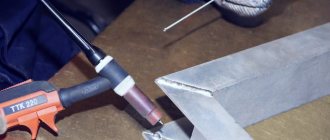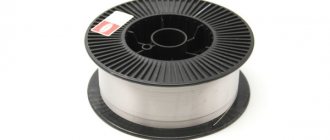When welding metal structures and other metal products, the method is often used gas shielded welding. In many cases, gas is used carbon dioxide, which effectively displaces atmospheric air from the metal melting zone.
Carbon dioxide welding technology was developed by Soviet scientists in the 50s of the 20th century.
For carbon dioxide welding, semi-automatic welding machines or automatic welding lines are used The review will discuss how to work with welding in carbon dioxide.
Carbon dioxide welding is applicable for the following metals:
- Cast iron
- Low and medium carbon steel
- Corrosion resistant low alloy steel
It should be immediately noted that carbon dioxide welding is not suitable for working with alloyed stainless steel, refractory high-strength alloys, and copper. The fact is that carbon dioxide enters into a chemical reaction with many metals and alloys, making the welding seam substandard.
What you need to know about carbon dioxide welding.
Specifics of technology
Welding in a carbon dioxide atmosphere is a type of electric arc .
The constant discharge of the electric arc releases a large amount of thermal energy, which heats and melts the metal of the workpiece. The current flows through the workpiece, the air gap and the infusible tungsten electrode. The welding material in the form of wire is fed into the working area separately; it does not serve as a conductor. Feeding is carried out at a constant speed by a feed mechanism built into the semi-automatic welding machine.
In order to protect the weld pool from the effects of oxygen and hydrogen in the air, as well as water vapor, a protective atmosphere consisting of carbon dioxide is supplied to the working area. Its cloud displaces air and prevents unwanted chemical reactions
Equipment and materials for carbon dioxide welding
For carbon dioxide processing, inverter-type semi-automatic welding machines with several operating modes are used. The power of such semi-automatic devices is determined by the scope of their application: for professional use, high- or medium-power units are used; weaker models are suitable for domestic use. Semi-automatic machines operate without electrodes; instead, a special wire enters the welding area.
The device itself is supplied by the manufacturer as a set of the following elements:
- a power supply unit consisting of a transformer and a wire-feeding electrode;
- sleeves (hose);
- burner equipped with wire inside;
- conductive tip (nozzle);
- node from where gas is supplied.
To increase productivity and avoid overheating of the burner, cooling systems are additionally used. The quality of welding and its efficiency depend on what kind of machine is used. When purchasing a welding machine, you need to pay attention to some indicators and characteristics.
The power must be sufficient. High-power machines make it possible to cook thicker materials. It is advisable to choose models with a removable holder. The kit should be accompanied by detailed instructions to make understanding the operation of the inverter much easier.
What is carbon dioxide?
The CO2 carbon dioxide molecule consists of a carbon atom and two oxygen atoms. Under normal conditions, carbon monoxide is a gaseous substance, heavier than air, colorless and odorless.
Carbon monoxide has low chemical reactivity, making it an excellent candidate for creating a protective atmosphere around the welding zone . The same property is used when operating carbon dioxide fire extinguishers, which stop the access of air oxygen to the source of fire.
At atmospheric pressure it cannot exist in a liquid state. When cooled to -78°C, it hardens, forming a loose mass reminiscent of snow. This is the so-called “dry ice” used for cooling products in the food industry and trade.
The substance is released during the oxidation of organic substances - during combustion, decay, and respiration of living organisms.
Technical conditions for industrial CO2 are regulated by GOST 8050-85.
The substance is transported in a gaseous state, in containers under pressure.
Scope of application
Carbon dioxide is significantly cheaper to produce than argon, helium and others, but is inferior to them in its protective properties. Welding in a CO2 atmosphere is used for ordinary joints made of ordinary structural steels .
For more critical structures, special steels, and highly loaded components, more expensive inert gases are used, which are difficult to store and use.
In the mass production of standard metal structures, the use of carbon dioxide to protect the welding zone makes a noticeable difference in cost.
Organizing CO2 storage is also cheaper.
Semi-automatic welding technology in CO2
Welding metal in a protective carbon dioxide environment is considered by professionals to be one of the most effective. Especially when it comes to joining thin workpieces or parts. That is why carbon dioxide welding is used to repair car bodies, the minimum thickness of which is 0.5 mm. The main advantages of this type of metal welding include:
- fairly high performance;
- slight heating of the workpieces being welded, which leads to minimal warping;
- you can weld seams in any position, and this is not difficult and does not affect the quality of the final result;
- favorable conditions for the welding process;
- minimal costs, since carbon dioxide itself is very cheap.
Shut-off and control equipment for cylinders
When working with nitrogen oxide, special shut-off and distribution valves are used .
The reducer reduces the input pressure from 100 atm. up to a working value of 3 atm. It is equipped with two pressure gauges: at the outlet and at the inlet, by which the welder monitors the pressure value.
The gearbox is equipped with two filters that retain impurities.
The required operating pressure is set by rotating the regulator handle.
Using union nuts, the device is connected to the cylinder and to the hose supplying the consumer.
In the event of an emergency, the safety valve releases excess pressure into the atmosphere.
All devices associated with carbon dioxide - cylinders, reducers, hoses - are marked in black.
How to properly weld with a semi-automatic machine
After you have chosen the desired feed speed and amperage, prepared the products, you need to adjust the flow of carbon dioxide and only after 30 seconds excite the arc and start welding so that the gas squeezes out the air from the hoses and channels of the welding torch.
The main thing is not to rush and before welding, be sure to practice on an unnecessary piece of metal, this way the welding will be of better quality. And only after all this you need to start the main work.
Welding methods:
- Angle forward, moving the burner from right to left. The metal melts less, the weld bead is wide. Used when welding thin metal:
- Angled backwards, the burner moves from left to right. The penetration depth is greater, the seam width is reduced.
Step by step welding process:
- Tilt the burner 5° from the vertical axis
- Start moving the electrode by analogy with manual welding, watch for good metal penetration and the formation of a high-quality bead. To avoid the risk of cracking, it is recommended to weld the first layer at low current.
- We complete the seam by filling the crater with metal.
- Stop the wire feed and turn off the current.
Gas continues to be supplied to the welded crater until the metal hardens.
In justified cases, regardless of the conditions of use of welded joints, welding can be done in a mixture with argon and with a carbon dioxide content of less than 50%, but not less than 15%.
We recommend! Do-it-yourself welding of polypropylene sheets
Refill features
A carbon dioxide cylinder for a semi-automatic machine is charged using two methods:
- bypassing from the storage tank through the reducer and flow meter into the refilled cylinder;
- pumping into a refillable cylinder using a compressor.
Regardless of the filling method, it is important to accurately determine the empty weight of the cylinder . By weighing the cylinder after filling, you can accurately determine the amount of CO2 injected.
Filling cylinders with carbon monoxide, unlike acetylene or oxygen, does not require extraordinary precautions. However, one cannot relax: in the event of a massive leak, carbon dioxide forms an atmosphere unsuitable for breathing. Therefore, it is necessary to carefully check the condition of cylinders, fittings and hoses for mechanical damage.
When refueling using the “cylinder to cylinder” method, it is recommended to turn the cylinder from which you refuel upside down and monitor its temperature.
Preparing for work
Before you begin, you should familiarize yourself with the controls that are located on the front panel:
- Welding current switch - allows you to set a weak current, which is suitable for thin metals and up to a stronger one (often 6), which is suitable only for thick metals.
- Wire feed speed is controlled by a separate switch
- Some semi-automatic machines are equipped with on-timers for more convenient spot welding.
- Hole for welding gun
Before connecting the device to power, make sure that the network has the appropriate voltage and power for the semiautomatic device.
Setting up and connecting welding equipment
- Insert the welding wire; its feed mechanism is located under the cover. Check the rollers that feed the wire into the machine, the guide hose and the electrode of the welding gun. They must be identical to the wire type and size. To use a different size wire, you need to change or turn over the drive roller. The size marking is cut into the side of the roller. Reels can have different mounting sizes. To do this, use special adapters. Before you begin the adjustment, you need to place the wire in the appropriate groove, then engage the adjustment roller. When pressing the roller, remember not to press too lightly (the wire will slip out a little) or too much (the wire will be deformed).
- Extend the feed hose to its full length, remove the nozzles and tip, then press and hold the button on the torch until the wire automatically comes out 10-15 cm. After this, you can put the tip and nozzle in place.
- Connect the protective gas cylinder to the device using a hose through the reducer and secure with clamps.
We recommend! How to weld aluminum with an inverter using an electrode
The device is now ready for use.
Preparing metals for welding in CO2
When welding very thin plates of low-alloy or carbon steel (0.5mm-1mm), it is worth flanging the edges. Without flanging, the space between the sheets during welding should not be more than 0.5mm. If the thickness of the sheets exceeds 1mm, then there is no need to do flanging, but the distance between the sheets should not exceed 1mm.
Before welding metals, it is worth removing unnecessary elements from them, such as oil, paint, dirt, etc. It is also advisable to remove rust.
Consumption
The carbon dioxide consumption for semi-automatic welding is determined by a combination of a number of factors.
- weather conditions (temperature, wind, humidity);
- quality of welding materials;
- qualification and experience of the welder.
It can vary from 3 to 60 liters per minute.
When calculating the planned consumption, such characteristics as the diameter of the welding wire and the thickness of the workpieces are taken into account. To the calculated value equal to the product of the specific consumption and the length of the seam, a margin of 10% is added for preparatory operations.
From a standard cylinder containing 25 kg of CO2, after reducing the pressure to working pressure, approximately 500-510 liters of gas are formed. At maximum consumption, this amount will be enough for 8 hours of operation of a semi-automatic carbon dioxide welding machine. On average, a bottle lasts for 15-20 hours.
Advantages and disadvantages
Working in a CO2 atmosphere has the following advantages over other types of welding:
- reliable protection of the welded zone from chemically active substances;
- cheapness;
- the ability to cook “by weight”, without the use of backing plates;
- stable arc on thin-walled workpieces;
- rational use of thermal energy of the electric arc.
In addition to its advantages, the method also has a number of disadvantages:
- low suitability for working with high-alloy alloys and non-ferrous metals;
- complexity of multilayer welding;
- danger of suffocation when working in unventilated areas.
The long preparation and startup time of the process makes it unsuitable for small volumes of welding work that need to be completed quickly.
Modes of semi-automatic welding in shielding gases
Depending on the thickness of the metals being welded, optimal welding modes in carbon dioxide are selected and welding equipment is adjusted. Table 1 shows the parameters that influence the choice of welding modes.
When analyzing the table data, important points should be noted:
- The penetration depth will increase with increasing welding current.
- Arc voltage is directly related to arc length. As it increases, the voltage also increases, and therefore the width and depth of penetration;
- The wire feed speed must ensure stable arc burning at the given voltage parameters;
- Electrode stickout ensures the stability of the arc burning process; as it increases, the properties of the arc and, accordingly, the quality of the weld deteriorate. At short overhangs, the welding process is poorly visible through the welding mask, and the contact tip often burns out.
- The overhang is selected depending on the diameter of the electrode wire used.
Now that we have understood the semi-automatic welding modes, let’s begin preparation and further work
Safety precautions.
Carbon dioxide has two potentially dangerous exposure factors:
- balloon explosion when heated;
- suffocation when working in a closed, unventilated space when the concentration level exceeds 5%.
Based on these risks, safety requirements for carrying out work with CO2 are formed.
During the transportation:
- all cylinders must be transported in a special pallet, in a vertical position;
- Each cylinder must have rubber safety rings.
During storage and refueling:
- all premises must be equipped with gas analyzing equipment;
- when filling the cylinder, it is necessary to control its temperature;
- it is not allowed to refill the cylinder above the standard value;
- Do not touch pipelines, hoses and fittings without protective gloves.
During operation:
- when working in a confined space, organize constant monitoring of CO2 content in the air;
- provide ventilation or provide the welder with an insulating mask with an air supply;
- work together, and one person should be outside the volume and monitor the condition of the welder.
If safety requirements are met, carbon dioxide does not pose a health threat.
Danger of carbon monoxide CO.
Carbon monoxide is a highly toxic substance . If inhaled, it leads to a general depression of body functions and severe poisoning. Death is also possible. It is allowed to work in a carbon monoxide atmosphere only in self-contained breathing equipment.
Polarity
The polarity when welding semi-automatically in a carbon dioxide environment is reversed, that is, “plus” is connected to the workpiece, and “minus” is connected to the electrode. When working with straight polarity in a CO2 environment, it will be difficult to ensure the stability of the electric arc . An unstable arc with such a connection scheme leads to weld defects.
Advantages and disadvantages of carbon dioxide welding
Despite its novelty, carbon dioxide technology has proven itself well and is used more often than other types of processing. A jet of carbon dioxide directed at the arc zone becomes a kind of protective medium, protecting the metal surface from nitriding, oxidation, and contact with air. If we talk about the advantages over gas welding, then:
- the supply of welding wire is automated;
- the area of temperature influence is 4 times smaller;
- There is practically no emission of harmful gases.
Carbon dioxide technology is indispensable when processing thin steel (up to 1 mm), as it does not deform the metal and forms a strong seam, which distinguishes it favorably from other types of welding. The processing speed of thin steel sheets is 5 times higher.
During the work, the metal practically does not heat up, which prevents wear of parts, and the connection itself is of high quality and beautiful.
Advantages compared to arc (manual) welding:
- prevents the harmful effects of oxygen on the metal surface;
- productivity is 4 times higher;
- the surface being treated can have any spatial position;
- The technique is easy to master even for beginners.
Carbon dioxide welding can replace acetylene welding. The quality of both types of treatment is the same, but the cost of carbon dioxide treatment will be much lower due to the low cost of gas and the materials used.
When using carbon dioxide, the arc ignites easily, burns steadily, and there is no need to frequently change the electrodes or clean them of slag crusts. This allows the welder to avoid running long distances while welding, which greatly increases productivity.
The disadvantages include the following factors:
- not all metals can be processed using carbon dioxide technology;
- the quality of the seam is weaker than when using argon mixtures;
- carbon dioxide mixtures of the required quality are not always available for sale;
- Equipment after using carbon dioxide is difficult to clean.
If the technology is violated or the wrong parameters are set, the components quickly wear out, which requires serious repairs and frequent replacement of components.

